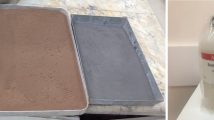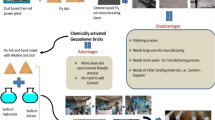Abstract
The use of the thermal power plant ashes including fly ash (FA) and bottom ash (BA) for producing unfired building bricks (UBB) using sodium hydroxide (NaOH) solution as an alkaline activator was investigated. A low applied forming pressure of 0.5 MPa and various NaOH concentrations of 5, 8, 10, and 12 M were used for the preparation of brick samples with different solution-to-binder (S/B) ratios of 0.35 and 0.40. The bricks were subjected to various test programs with reflecting the effect of both NaOH concentrations and S/B ratios on the brick’s properties. The compressive strength, unit weight, ultrasonic pulse velocity, and thermal conductivity of bricks increased with increasing NaOH concentration, whereas the contrary trend was found with increasing S/B ratio. Also, the water absorption of bricks was observed to reduce with increasing NaOH concentration and decreasing S/B ratio. As the results, the combined utilization of both low forming pressure and coal power plant ashes can produce the UBBs with low unit weight, low heat conductivity, and acceptable strength and water absorption rate as stipulated by TCVN 6477–2016. Furthermore, the outcomes of chemical analysis and microstructure observation also demonstrate that a high concentration of the NaOH promoted the geopolymerization process. Notably, the use of NaOH solution of either 10 M or above is recommended for the production of UBBs, which are classified as grade M5.0 or higher.
Similar content being viewed by others
References
Chindaprasirt P, Jaturapitakkul A, Chalee W, et al. Comparative Study on the Characteristics of Fly Ash and Bottom Ash Geopolymers[J]. Waste Manage., 2009, 29(2): 539–543
Rafieizonoor M, Mirza J, Salim MR, et al. Investigation of Coal Bottom Ash and Fly Ash in Concrete as Replacement for Sand and Cement[ J]. Constr. Build. Mater., 2016, 116: 15–24
Singh M, Siddique R. Effect of Coal Bottom Ash as Partial Replacement of Sand on Workability and Strength Properties of Concrete[J]. J. Clean. Prod., 2016, 112: 620–630
Kurama H, Kaya M. Usage of Coal Combustion Bottom Ash in Concrete Mixture[J]. Constr. Build. Mater., 2008, 22(9): 1922–1928
Turgut P. Masonry Composite Material Made of Limestone Powder and Fly Ash[J]. Powder Technol., 2010, 204(1): 42–47
Chindaprasirt P, Pimraksa K. A Study of Fly Ash-Lime Granule Unfired Brick[J]. Powder Technol., 2008, 182(1): 33–41
Zhang Z, Qian J, You C, et al. Use of Circulating Fluidized Bed Combustion Fly Ash and Slag in Autoclaved Brick[J]. Constr. Build. Mater., 2012, 35: 109–116
Hwang CL, Huynh TP. Investigation into the Use of Unground Rice Husk Ash to Produce Eco-Friendly Construction Bricks[J]. Constr. Build. Mater., 2015, 93: 335–341
Hwang CL, Huynh TP. Evaluation of the Performance and Microstructure of Ecofriendly Construction Bricks Made with Fly Ash and Residual Rice Husk Ash[J]. Adv. Mater. Sci. Eng., 2015, 2015: 1–11
Hwang CL, Huynh TP, Risdianto Y. An Application of Blended Fly Ash and Residual Rice Husk Ash for Producing Green Building Bricks[J]. Journal of the Chinese Institute of Engineering, 2016, 39(7):850–858
Shakir AA, Naganathan S, Mustapha KN. Properties of Bricks Made Using Fly Ash, Quarry Dust and Billet Scale[J]. Constr. Build. Mater., 2013, 41: 131–138
Kumar A, Kumar S. Development of Paving Blocks from Synergistic Use of Red Mud and Fly Ash Using Geopolymerization[J]. Constr. Build. Mater., 2013, 38: 865–871
Cicek T, Tanrverdi M. Lime Based Steam Autoclaved Fly Ash Bricks[J]. Constr. Build. Mater., 2007, 21(6): 1295–1300
Kumar S. A Perspective Study on Fly Ash-Lime-Gypsum Bricks and Hollow Blocks for Low Cost Housing Development[J]. Constr. Build. Mater, 2002, 16(8): 519–525
Freidin C. Cementless Pressed Blocks from Waste Products of Coal-Firing Power Station[J]. Constr. Build. Mater., 2017, 21(1): 12–18
Chen C, Lin Q, Shen L, et al. Feasibility of Manufacturing Geopolymer Bricks Using Circulating Fluidized Bed Combustion Bottom Ash[J]. Environ. Technol., 2012, 33(11): 1313–1321
Naganathan S, Mohamed AYO, Mustapha KN. Performance of Bricks Made Using Fly Ash and Bottom Ash[J]. Constr. Build. Mater., 2015, 96: 576–580
Naganathan S, Subramaniam N, Mustapha KN. Development of Brick Using Thermal Power Plant Bottom Ash and Fly Ash[J]. Asian Journal of Civil Engineering, 2012, 13(1): 275–287
Ministry of Science and Technology. Concrete Brick[S]. Vietnamese standard TCVN 6477, 2016 (in Vietnamese)
Huynh TP, Hwang CL, Lin KL. Performance and Microstructure Characteristics of the Fly Ash and Residual Rice Husk Ash-based Geopolymers Prepared at Various Solid-to-Liquid Ratios and Curing Temperatures[ J]. Environ. Prog. Sustainable Energy, 2017, 36(1): 83–92
Hou Y, Wang D, Zhou W, et al. Effect of Activator and Curing Mode on Fly Ash-Based Geopolymers[J]. Journal of Wuhan University of Technology - Materials Science Edition, 2009, 24: 711–715
Hanjitsuwan S, Hunpratub S, Thongbai P, et al. Effect of NaOH Concentrations on Physical and Electrical Properties of High Calcium Fly Ash Geopolymer Paste[J]. Cem. Concr. Compos., 2014, 45: 9–14
Rattanasak U, Chindaprasirt P. Influence of NaOH Solution on the Synthesis of Fly Ash Geopolymer[J]. Miner. Eng., 2009, 22(12): 1073–1078
Kolias S, Georgiou C. The Effect of Paste Volume and of Water Content on the Strength and Water Absorption of Concrete[J]. Cem. Concr. Compos., 2005, 27(2): 211–216
Carcao RS, Moreno EI. Evaluation of Concrete Made with Crushed Limestone Aggregate Based on Ultrasonic Pulse Velocity[J]. Constr. Build. Mater., 2008, 22(6): 1225–1231
Bogas JA, Gomes MG, Gomes A. Compressive Strength Evaluation of Structural Lightweight Concrete by Non-Destructive Ultrasonic Pulse Velocity Method[J]. Ultrasonic, 2013, 53(5): 962–972
Kim KH, Jeon SE, Kim JK, et al. An Experimental Study on Thermal Conductivity of Concrete[J]. Cem. Concr. Res., 2003, 33(3): 363–371
Uysal H, Demirboga R, Sahin R, et al. The Effect of Different Cement Dosages, Slupms, and Pumice Aggregate Ratios on Thermal Conductivity and Density of Concrete[J]. Cem. Concr. Res., 2004, 34(5): 845–848
Liew YM, Kamarudin H, Bakri AM, et al. Optimization of Solids-to-Liquid and Alkali Activator Ratios of Calcined Kaolin Geopolymeric Powder[J]. Constr. Build. Mater., 2012, 37: 440–451
He J, Jie Y, Zhang J, et al. Synthesis and Characterization of Red Mud and Rice Husk Ash-Based Geopolymer Composites[J]. Cem. Concr. Compos., 2013, 37: 108–118
Davidovits J. Geopolymers: Inorganic Polymeric New Materials[J]. J. Therm. Anal., 1991, 37(8): 1633–1656
Hwang CL, Huynh TP. Effect of Alkali-Activator and Rice Husk Ash Content on Strength Development of Fly Ash Residual Rice Husk Ash-Based Geopolymers[J]. Constr. Build. Mater., 2015, 101: 1–9
Fraay ALA, Bijen JM, Haan YM. The Reaction of Fly Ash in Concrete-a Critical Examination[J]. Cem. Concr. Res., 1989, 19(2): 234–246
Acknowledgments
The experimental works were carried out at the construction material laboratory of the Department of Engineering and Technology, Hong Duc University, Viet Nam.
Author information
Authors and Affiliations
Corresponding author
Additional information
Conflict of interest
On behalf of all authors, the corresponding author states that there is no conflict of interest.
Rights and permissions
About this article
Cite this article
Si-Huy, N., Thanh-Tam, L.T. & Trong-Phuoc, H. Effects of NaOH Concentrations on Properties of the Thermal Power Plant Ashes-Bricks by Alkaline Activation. J. Wuhan Univ. Technol.-Mat. Sci. Edit. 35, 131–139 (2020). https://doi.org/10.1007/s11595-020-2236-2
Received:
Accepted:
Published:
Issue Date:
DOI: https://doi.org/10.1007/s11595-020-2236-2




